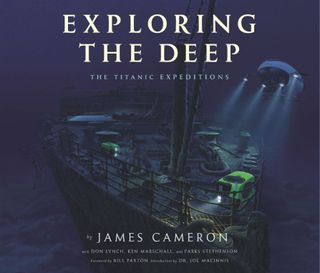Titanic Expert Talks New Book, Working with James Cameron

James Cameron and his collaborators have made more than 30 dives to the wreck of the Titanic, submerged in more than 2 miles (3.8 kilometers) of water beneath the North Atlantic. His voyages to this most famous shipwreck, enabled by his own technical innovations, such as remotely operated vehicles, have changed historians' knowledge about the Titanic and how it sank.
Titanic expert Parks Stephenson worked with Cameron on these voyages to the ship's remains and helped organize explorations of the ship's interior. He also got to dive to the Titanic himself in a Russian submersible.
Stephenson is the co-author, with Cameron, Don Lynch and Ken Marschall, of a book published this month entitled "Exploring the Deep: The Titanic Expeditions." The richly illustrated book tells the story of the group's many dives to the ship, as well as the making of the "Titanic" movie. It also features many previously unpublished photos from within the wreckage. [Stunning Shots of the Titanic Shipwreck]
Stephenson, who made the first-ever accurate computer-generated imagery of several of Titanic's (formerly) plush rooms, talked to LiveScience about his work detailing the ship's technical history and the stories in the book.
LiveScience: What was it like to dive to the wreckage of the Titanic?

Parks Stephenson: It's a three-hour drop to the bottom. I had spent a lot of time prior to the dive studying thousands of high-def images. What really shocked me was how the Titanic's wreckage appeared so much larger in 3D than in the 2D images.
You're awestruck seeing it in its entirety. But also aware quite a lot of people died on the Titanic, and you're down there alone with it. I would say the hairs on the back of my neck were standing up most of the time we were down there. It really had a haunted-house feeling to it.
Sign up for the Live Science daily newsletter now
Get the world’s most fascinating discoveries delivered straight to your inbox.
Originally, I wasn't scheduled to dive down there. Jim (Cameron) knew I was disappointed about [this]. As I was leaving Canada after one of our trips to the wreck, a production assistant ran up to me and said that Jim wanted to talk on the phone. "Do you want to dive?" He asked. Of course I said "yes."
He had paid for another dive to go down to clean up [cables left by submersibles that previously descended to the site], and said I could go along. For that, I will always be grateful.
LS: What was it like working with James Cameron?
P.S.: I have great respect for the man. He's very knowledgeable in anything he attempts.
He's a very demanding person. I know he has a reputation for being very exacting and flying off the handle at times, but my experience is that he only ever gets mad at somebody who isn't pulling their own weight or contributing, [who] is a liability. But he organizes diving to bottom of the ocean and operating a high-budget film — he can't afford to have somebody like that.
If you really contribute, he'll do anything for you.
LS: What was your favorite finding on the Titanic?
P.S.: I provided info to Jim that allowed him to find the ships' communication system, the Marconi wireless transmitter, which allowed us to reconstruct what it looked like. It was a new technology [at the time] that allowed ships to talk to land, which wasn't possible only a few short years previously.
LS: Tell me about the book.
P.S.: We needed a book to document the work Cameron had done, our analysis and our conclusions. It kind of ties the bow on his decade or so of activity related to the Titanic. [Titanic Quiz: Fact or Fiction]
LS: How'd you get involved working with Cameron, and eventually making the book?
P.S.: I was friends with book co-author Ken Marschall, visual historian for the "Titanic" movie. I helped Cameron with some technical work before his 2001 dive to the wreckage and got brought on board after that.
LS: What were some of the conclusions from your work on the Titanic with Cameron?
P.S.: One of the most interesting conclusions to come from the exploration of the ship's interior — besides revelations about places that have survived intact, like the Turkish bath or the Marconi room — was the manner in which the ship broke apart, and how the Titanic sank.
Based on computer modeling Jim funded and observations, we've been able to put together a credible breakup scenario. That had never been done in a scientific manner.
We've debunked recent theories suggesting the Titanic had weak rivets, was of poor design or poor quality. A lot of people were pointing to flaws in the ship itself. We found the Titanic was quite a well-built ship and endured stress no other ship in the area could have. It's actually remarkable that it floated for 2 hours and 40 minutes after hitting the iceberg. The designer of the ship only gave it one to 1.5 hours once he heard about the damage.
We've basically replaced junk science with real science.


Email Douglas Main or follow him on Twitter or Google+. Follow us @OAPlanet, Facebook or Google+. Original article on LiveScience's OurAmazingPlanet.
Most Popular


